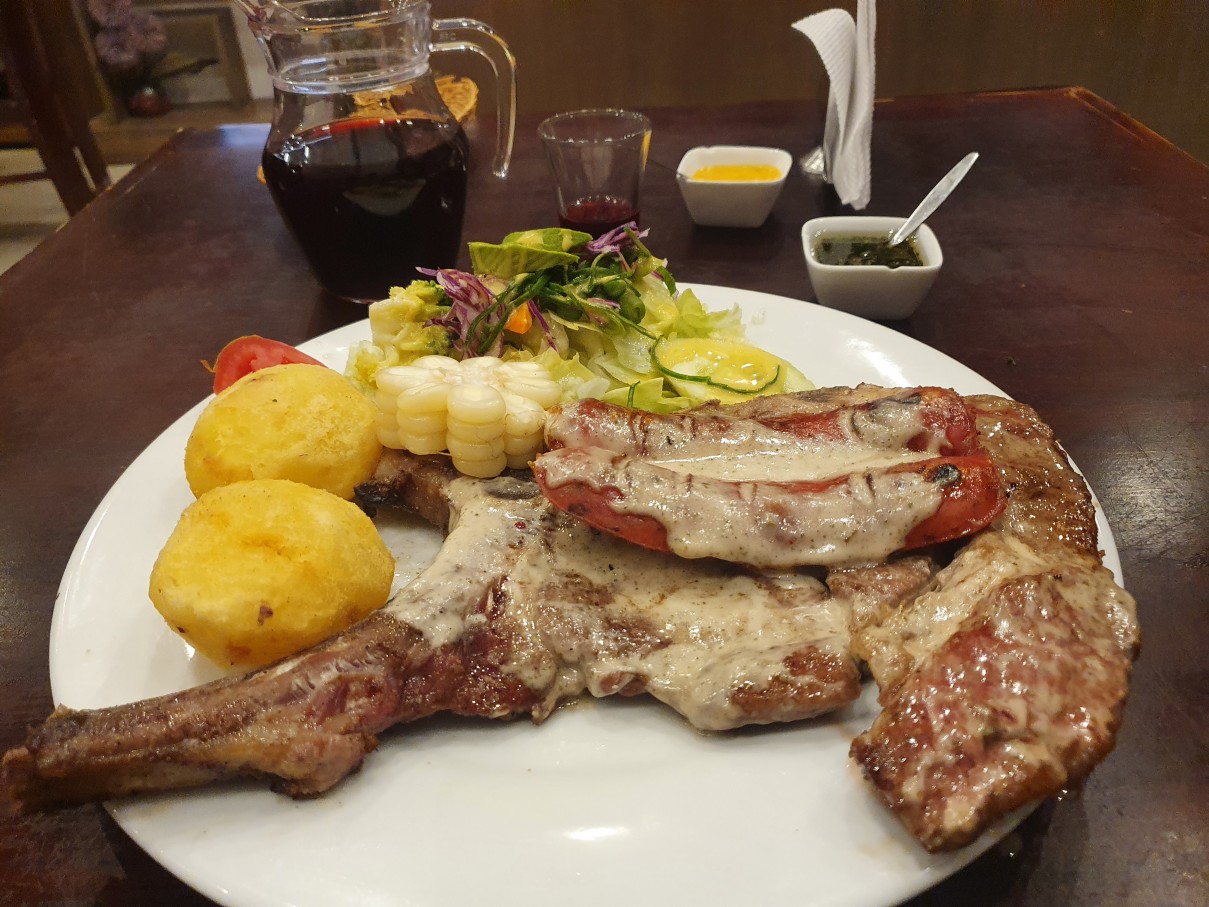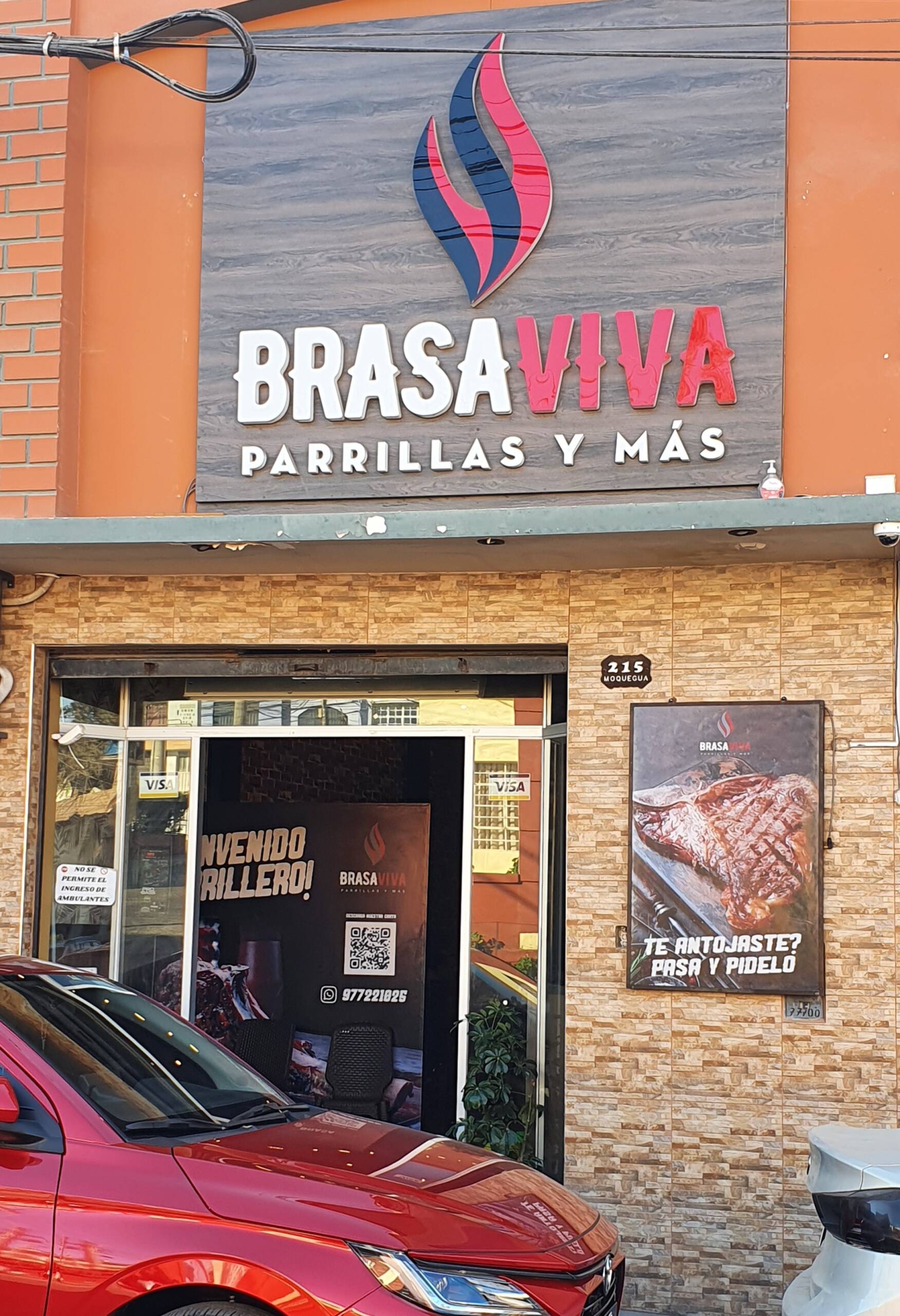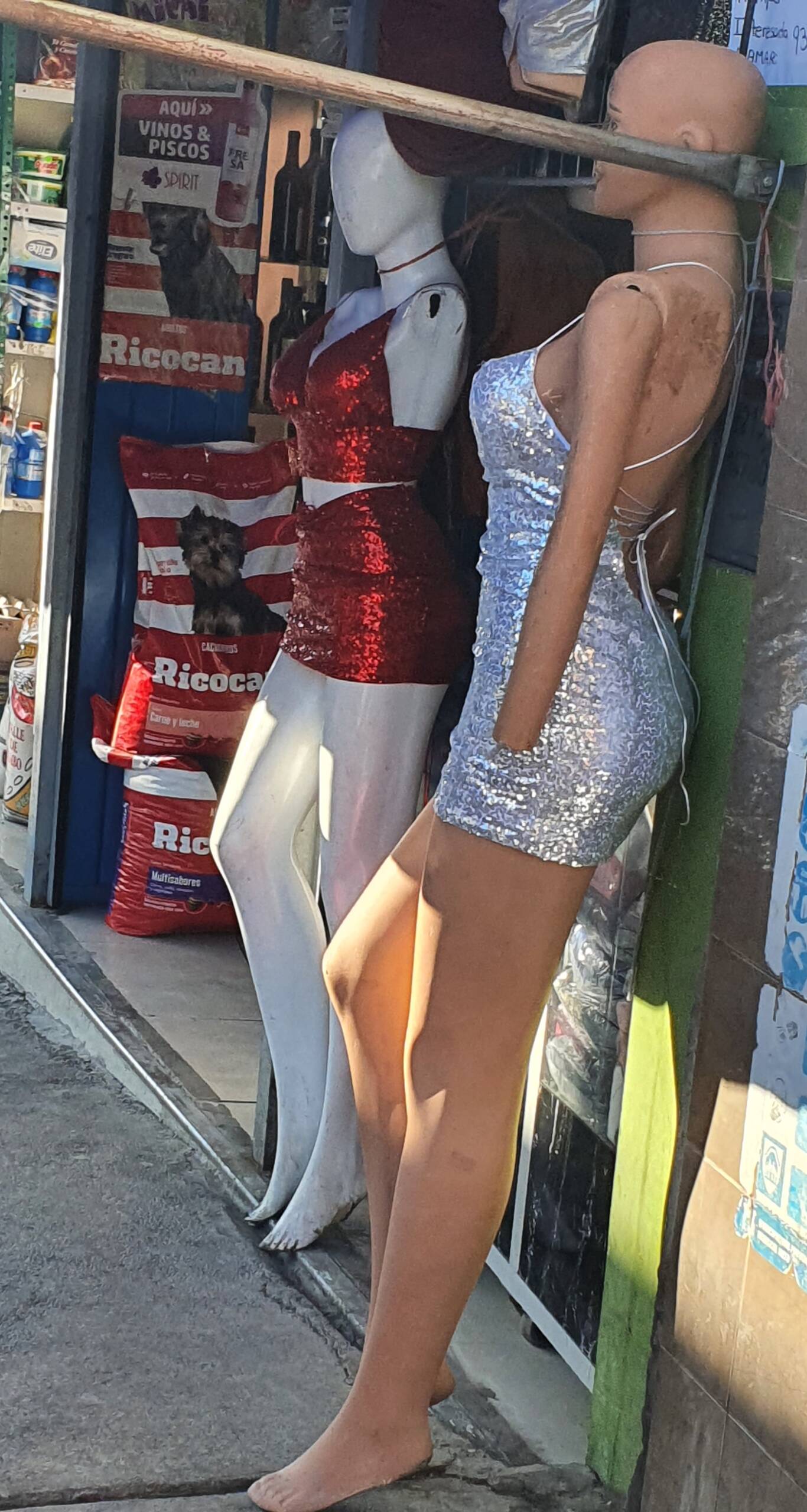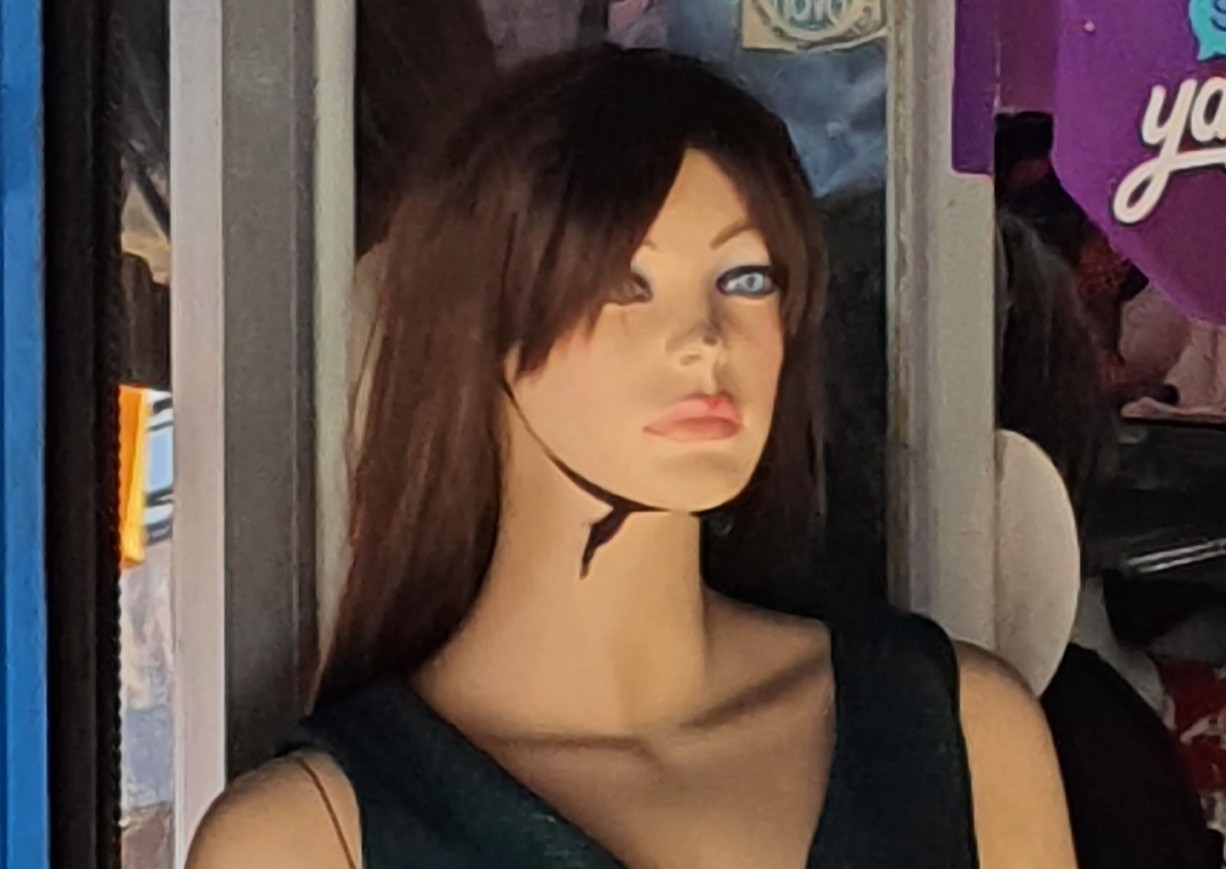For its fair quality-price ratio, the Brasa Viva is arguably the most popular grillroom in Moquegua’s capital city (we are in Peru). Its online rating is high and, unsurprisingly, it is usually full during eating peak hours, despite its fast-food style approach: with a limited range of dishes, quick service and an “order, eat (in or away), pay and leave” philosophy. Your order is taken as soon as you’ve made up your mind and, in little over five minutes, you are already enjoying your meal. But since there are not many tables (and rather small, at that) and many Moqueguanos like to go there for dinner, especially in the afternoon there is often at the door a line of customers waiting for others to finish.
As its name suggests (“vivid ember”), it specializes in grilled meat, and though the cuts are not the best on the market, they are acceptable and fairly sized, coming alongside a potatoes and salad side-dish. They also serve reasonably priced and more than passable Peruvian wine (alas! usually only semi-sweet or semi-dry) in jugs. A good place, in short, where to eat a few times for getting an idea of the most popular national meat dishes without draining your wallet empty: for less than 40 soles (that’s 11 USD and no tip expected, so please do not go around the show-off gringo way spoiling lovely, deep-seated, low-budget and backpacker-friendly Peruvian habits, okay?) you can have a beef, pork, lamb, chicken or anticucho barbecue, plus a chorizo slice, including the garnish and drink.

Small calf chop, side-dish and 1/2 jar of wine
At a table next to mine in the Brasa Viva there are two young Incas who, judging from their countenances and skin colour, seem to have just been pulled out Manco Yupanqui‘s hosts, then passed through Manko You-punky’s stylist: temples shaved the punk or Goth style, piercings and earrings, nails lacquered in black. Because I am so backward, first thought coming to my mind is: Is this an instance of identity politics, of cultural diversity, of interculturality, or none of the above? I must admit I get lost in the dense forest of liberal-progressive ideological vocabulary and semantics. But think you not that I am describing this scene out of demean: I believe in the right of Quechuas to disfigure themselves with such tokens of the degenerate Western aesthetics. It’s just that–well, it is doubly striking to see those alien looks on these people, whose habits and traditions are so far away from a fashion which, seen here, seems utterly extemporaneous and out of place; a fashion imported -thanks to the media culturally meddling everywhere- from a hemisphere without any relation with the pre-Columbian folkloric heritage prevailing in Spanish America until very recently. One can’t but think: that style does not belong here at all.
And this is precisely why our world puppeteers’ ability to simultaneously promote “identity and diversity” alongside an alienating cultural homogeneity amazes me so much, and I wonder what’s the possible goal behind carrying out both -seemingly opposite- policies at the same time. Are they are trying to maximize both imagined -or delusional- heterogeneity and real homogeneity? In other words: to make it so that peoples, believing to be very different from each other, are actually very similar and behave, think and feel in the same way? Maybe; and I am very much afraid the vaunted multiculturalism boils down to precisely just that.
Another particular I find also shocking in Peru, somehow related to the damned ideologization -but because in this case it is oddly missing-, are the mannequins. Yes: those prosaic dummies we see in clothing stores. As turns out, it is very common in the West -and increasingly so- to everywhere see mannequins physically resembling racial minorities’ individuals (mainly black-looking, but the Asian-looking are getting trendy too), who are thus -with regards to this commerce- often over-represented in our societies, where the actual numbers of those minorities rarely go beyond 10-15% of the population; which of course should surprise no one, since the West, as the multiculturalism’s intellectual author, must consequently virtue-signal and broadcast to the rest of the world its tolerance, pluralism and “racial integration” message. However, in Peru (alike, I guess, other American countries with similar characteristics), where Caucasians amount to less than 1% of the population, mannequins are all incongruously white-looking, with features (even blue eyes and blond hair!) the like of which you almost never come across here (and if you do, you can bet she’s a tourist). Now, and taking into account how universal and ubiquitous the monolithic thinking’s ideological slogans are, this does beg some explanation. Why do dummies in an overwhelmingly Amerindian-populated country do not look Amerindian at all?
It may be suggested that there is perhaps no mannequin-producing industry in Peru and therefore such items need to be imported; which is quite plausible, despite that I can hardly think of any other product requiring less technology to be manufactured, except maybe cement blocks and metal foil. And yet, import them from where? From the USA? Is there not a single country south of Rio Grande -and closer to Peru- making dummies? And, in any case, has someone not received the relevant and compulsory instructions from the WEF to mass-produce, mass-import or mass-purchase mannequins in the “ethnic pride” version? I am afraid someone should be demoted at Klaus Schwab’s think tanks, because this particular war front has escaped them. Not that I suddenly became a supporter of Davos’ ideological agenda (God forbid!), but even the most die-hard opponent of those doctrines will shy away when, moseying through the maze of aisles of any Peruvian marketplace, crowded with tobacco-skinned, pitch-black haired, indigenous Aymara people, suddenly comes across any of those blue-eyed Barbie-doll mannequins, standing out among the locals (and often dressed, by the way, in the most hideously cheesy garments ever made in the history of the textile industry) like a fly on the milk.
And since I am at the topic of cultural indoctrination, here is another scene I witnessed last month in Copiapó (Chile), of an evening, as I was sauntering along the streets: A small crowd of very progressive and politically correct young Mapuches (broadly speaking) were parading, or perhaps demonstrating, in favour of the LGBTQ ideology, showcasing the de rigueur rainbow flags and regalia. The march, I bet, must have been organized by any of the endless mobilization outlets spread out worldwide by globohomo.
And is that it?–you’d say. That is nothing extraordinary! And you’d be right. But that’s the problem. First off, let me state the usual disclaimer: Chileans are as entitled as the next to believe the idea that there are 81 gender identities, and I fully support their right to do so. But once this out of the way, few things seem to me less belonging and native to the traditionally patriarchal and sexist ethnic, religious and cultural “identity” of Spanish-American peoples, than demonstrating and advocating for homosexuality; and here once more I come across an apparent contradiction between two of the globalist ideological mosaic’s postulates: identity politics vs gender agenda. Except that maybe there is no such contracition after all, if the values promoted by the world puppetmasters behave in the same way as the “orders of infinity” I studied at college: although the idea of infinite be univocal (“That which is boundless, without limits”), not all infinites are alike: some are more boundless than others; and so it might happen that, in the hierarchy of postmodern ideology, the LGBTQ doctrine would take precedence over cultural diversity, which latter -being a lesser principle- would thus be partially “abrogated” or nullified insomuch as it goes against the former. In other worlds: good and compliant citizens of the new world order are urged and encouraged to preserve and be proud of their own identity and cultural traits as long as these do not collide with any of the higher-ranking principles in the globalist dogmatic corpus. Which, in the end, cuts down to a minimum multiculturalism’s leeway for expression, since no society would be allowed to show, protect or maintain anything outside the narrow limits imposed by the main pillars of the One Thought; i.e., nothing beyond some craftworks, clothing, ethnic music and a traditional dish, vegetarian if possible.
But please tell me where my thoughts went amiss.



